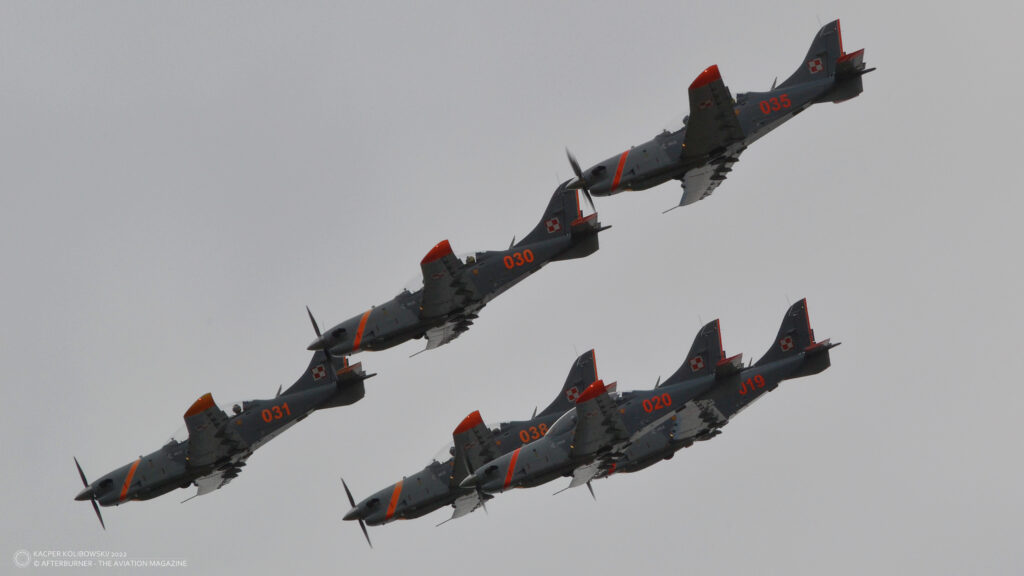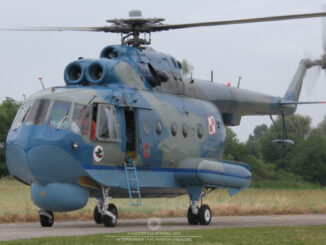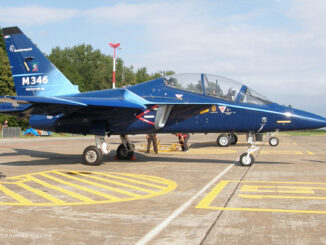 PZL-130 TC-II Orlik (Zespół Akrobacyjny Orlik of the Polish Air Force), flypast during opening ceremony of the 2022 FAI F2 World Championship for Control Line Model Aircraft for Seniors and Juniors in Włocławek, July 2022.
PZL-130 TC-II Orlik (Zespół Akrobacyjny Orlik of the Polish Air Force), flypast during opening ceremony of the 2022 FAI F2 World Championship for Control Line Model Aircraft for Seniors and Juniors in Włocławek, July 2022.
In 1978, piston-powered PZL TS-8 Bies (English: devil) training aircraft were finally withdrawn from active service in Polish military aviation. Since then, jet-powered PZL TS-11 Iskra (English: spark) aeroplanes became the only training aircraft of the Polish Air Force. Although performing their duties well enough, those jets cannot ensure the whole spectrum of training purposes and it soon became clear that for basic course, a successor to Bies was needed.
At the turn of the 1970s and 1980s, especially among the Western air forces, propeller-driven training aircraft with performance and flying characteristics similar to jets began to gain popularity. Therefore, that new Polish training aeroplane was to be a sort of Eastern answer to this trend.
As early as in 1981, preliminary design for the new aircraft – designated PZL-130 Orlik (English: eaglet) – was developed by a team of aircraft designers from PZL Okęcie, led by Andrzej Frydrychewicz. Because the aeroplane was intended to complement the aforementioned TS-11 jets, it was designed to be as similar to them as possible in many respects.
Work on four prototypes of the aircraft began in 1982. On 12th October 1984, the PZL-130 took-off for the first time, flown by Witold Łukomski, test pilot of PZL Okęcie. At the time of its maiden flight, the aeroplane was equipped with a Vedeneyev M-14Pm radial engine of 330 hp.
In 1985, the PZL-130 Orlik had its international premiere, as the aircraft was presented at the 36th Paris Air Show at Le Bourget airport, where it attracted significant interest. As a result, at the end of the same year, the fourth prototype of aircraft was sent to Canada for the purpose of upgrade that would make it even more attractive for potential Western customers.
Most notably, the radial engine of Soviet origin was replaced with a turboprop Pratt & Whitney Canada PT6A-25A propulsion unit. In addition, Orlik received new avionics, oxygen system and the existing pneumatic installation was replaced with a hydraulic one. In addition, four hardpoints for external fuel tanks or armament were installed under the wings of the aircraft. Such modified aeroplane received new designation PZL-130T Turbo Orlik and was first flown on 13th July 1986.
Nevertheless, the first target customer, the Polish Air Force, was initially not convinced by Orlik design and showed weak interest in the aircraft. Therefore, the aeroplane was presented in China and then Canada, Ireland, Greece and South American countries. Columbia seemed to be one of the most promising customers, with intention to to purchase 80 examples. Regrettably, a tragic crash of the Turbo Orlik aeroplane that occured in that country in 1987, shattered those plans. The accident that resulted in death of Polish and Colombian pilots, caused that South America lost interest in the aircraft. As a consequence, works on the PZL-130T were suspended.
In the meantime, works on piston engine powered versions of Orlik continued. Two next prototypes featuring increased wingspan and equipped respectively with M-24Pm and PZL-Kalisz K8-AA (Polish-made licensed version of the M-14Pm) engines were built. Both aircraft were then handed over to the Polish Air Force for testing and evaluation. However, with the one final conclusion – works on the turboprop version of the Orlik had to be resumed.
This led to creation of another version of the aeroplane, designated PZL-130TM and equipped with Czech-made Walter M601E engine. It was handed over to the military aviation in 1991 and this time the evaluation of the prototype was positive. As a result, the two previous prototypes of Orlik were re-fitted with the same type of engine and also handed over to the air force. During evaluation of the prototypes, the Polish Air Force issued additional requirements for Orlik, such as adaptation to IFR, ability to perform aerobatics or use the aircraft to practise combat against air and ground targets.
In 1992, in order to meet the abovementioned requirements, another prototype was build, powered by M601E engine with a five-blade propeller and featuring cabin equipment similar to that of the TS-11. Thus equipped, the aircraft received designation PZL-130TB and in 1993 was approved for service military aviation. It was then developed into an upgraded variant, named TC-I and equipped with Martin-Baker ejection seats, improved avionics systems and flight recorder.
Eventually, the Polish Air Force placed an order for 48 examples of the PZL-130TB. The first serial manufactured aircraft were ready in 1994 and assigned to 60 Lotniczy Pułk Szkolny (the 60th Aviation Training Regiment) from Radom.
By the end of 1998, all the Orlik aircraft of the TB variant were eventually converted to the TC-I version. What´s more, in 2004 testing of a newer version began, designated PZL-130 TC-II. In comparison to previous variants it had larger wings, modified rudder and a new PT6-25C engine of more power and better performance, equipped with new propeller. Other changes included avionics systems and slightly elevated instructor’s position in the cabin, to improve forward visibility.
Initially, ten of the thirty seven PZL-130 aircraft then in service with the Polish Air Force had to be modernised to the TC-II variant. Eventually, as much as twenty eight aircraft were upgraded to the aforementioned standard, although that process was longer than expected and it took more than five years before the decision was taken. Subsequently, a prototype of TC-III version was presented, equipped with even better avonics and a HUD.
On 11th January 2010, a contract was signed between the Polish Air Force and the aircraft manufacturer EADS PZL Warszawa-Okęcie S.A., for another modernisation of sixteen Orlik aircraft from the TC-I to TC-II Garmin variant, equipped with Garmin avionics systems. That upgrade programme was concluded in September of 2013.
A year later, preparations were being made to upgrade twelve PZL-130s to the newest standards designated as TC-II Glass Cockpit version. Eventually, that idea was abandoned in 2017 but later that year a contract was signed to upgrade the aforementioned number of PZL-130 TC-I aircraft to a version known as TC-II Advanced.
The PZL-130 TC-II Advanced features a number of construction improvements, such as new wings, a redesigned tail section of the fuselage, revised cockpit canopy and engine bed. Significant improvements have also been made to electronics of the aeroplane by adding modern integrated multifunction displays, TAWS and air traffic information systems. Further upgrades included on-board radio, air-conditioning and electrical system of the aircraft. In addition, the current Pratt & Whitney Canada PTA6-25C engine was replaced with its more powerful, 760 hp version with four blade Hartzell propeller.
Initially, sixteen aeroplanes of the TC-II version were upgraded to the TC-II Advanced. Nevertheless, in order to significantly extend service life of Orlik aircraft with the Polish Air Force, soon after the decision was made to modernize all the PZL-130 aeroplanes remaining in active service to the TC-II Advanced variant by 2021.
In conclusion, it remains to be said that eventually all foreign expansion efforts went nowhere and the Polish Air Force remained the sole operator of the aircraft. Nevertheless, the PZL-130 aeroplane gained international recognition thanks to Zespół Akrobacyjny Orlik (Orlik Aerobatic Team) – the official aerobatic group of the Polish Air Force that was established in 1998. From its very begining, the team is flying with the PZL-130 aircraft, participating on regular basis in several European aviation events every year.
On 8th August 2022, the team made a flypast in a formation of six aircraft over Włocławek Aeroclub airfield in Kruszyn, Poland. It was a part of the opening ceremony of the 2022 FAI F2 World Championship for Control Line Model Aircraft for Seniors and Juniors. And it was exactly when the photo we now feature within our Photo of the Week series was taken.



